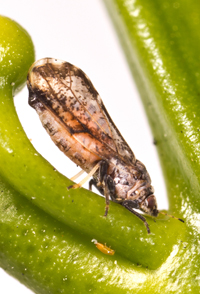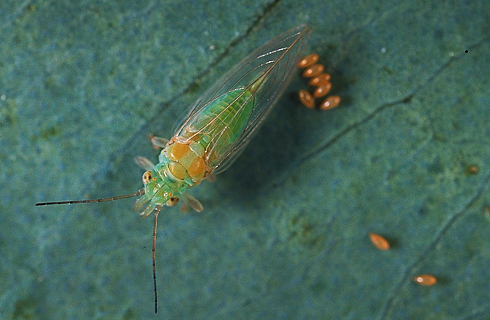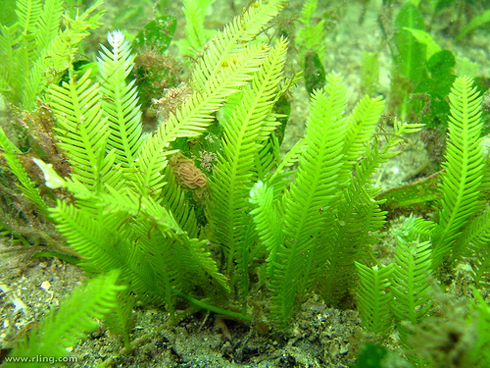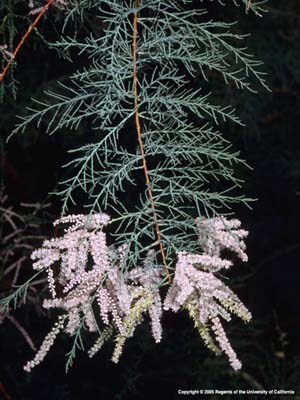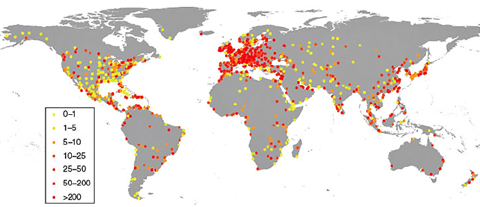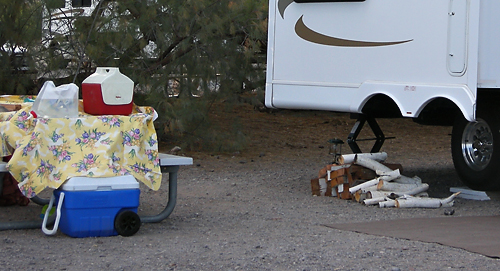Frequently Asked Questions About Invasive Species
-
What are invasive species?
Invasive species, alien species, exotic pests, bio-pollution, non-indigenous species, or invasive alien species, are common names that categorize non-native animals, microbes, diseases, or plants that are pests. These pests are not native in areas in which they cause problems and they are considered "invasive" because they invade and establish populations in new areas and the resulting uncontrolled population growth and spread causes economic or environmental problems.
-
Where do invasive species come from?
Invasive species are often native to a country or area different to that in which they have invaded and are now causing problems. On average, California acquires around nine new species of macro-invertebrate per year, of which around three will become pests. This is a rate of one new species every 40 days. Hawaii and Florida acquire new species at a rate of around 15 per year.
An example of invasive species that are not native to California are the persea mite and avocado thrips that attack avocados. Persea mite and avocado thrips are native to Mexico, one of the countries where avocados evolved. These two pests were accidentally introduced into California and because there are lots of commercially-grown and backyard avocados for them to feed and reproduce on, and California has such an agreeable climate where avocados are grown, they readily established and caused problems.
On the other hand, some species that are native to a country can be invasive if they are moved to another part of the same country. For example, in California, the glassy-winged sharpshooter is a serious pest of grapes because it spreads a bacteria that kills grapes. Interestingly, the glassy-winged sharpshooter is native to the USA and is found naturally in Florida, Louisiana, Mississippi, and Texas. However, this insect is not native to California and it was accidentally moved on ornamental plants from the Southeast USA to California in the late 1980's. Once established in Southern California, populations of this pest grew to very high densities and it spread into many different areas of California where grapes and other crops are grown.
Another example of a native American species causing problems in California are north American bullfrogs. These large frogs are native to areas east of the Rocky Mountains. These amphibians were likely introduced into California in the late 1890's where they are now threatening native California frog and fish species because of competition for resources and their ability to spread frog killing diseases like the chytrid fungus. Threatened native California species did not evolve with the bullfrog and they have difficulty coexisting with this aggressive competitor.
-
Why are invasive species a problem?
Invasive species cause a wide diversity of economic and environmental problems which almost always arise from uncontrolled population growth and spread in the area which has been invaded. Economic problems arise from the costs required to control invasive species, to reduce their rate of spread, or the need to inspect agricultural products that are being exported that may accidentally move the invasive pest to a new area.
These economic impacts are most severe in agricultural systems and urban areas where people's livelihoods or quality of life are affected. For example, successful invasions by agricultural pests results in greater costs to farmers who must control the new pest, often with pesticides. Consequently, food costs more to produce because of increased pest management expenses, and the risk to the environment, such as accidental pollution of water and air with pesticides, increases too. An example of a recent serious economic threat to California citrus growers is the Asian citrus psyllid.
Urban problems can be caused by invasive ant and termite species that create trouble in homes, and also tree pests that kill ornamental trees. A recent example of a serious ornamental tree pest was the red gum lerp psyllid which killed thousands of red gums in California. This pest cost home owners, utility companies, regional councils, and county managers millions of dollars for the expensive removal and disposal of very large dead trees.
Invasive species can cause major environmental problems too, especially in natural or wilderness areas. These problems are often largely unnoticed or ignored because there is no obvious and readily identifiable stakeholder group, such as home owners or avocado growers, that is being adversely affected .
Environmental problems caused by invasive species can be the extinction of native animals (e.g., the brown tree snake in Guam has caused the extinction of native bird species). Invasive weeds are often responsible for the drastic modification of native ecosystems. For example, invasive weeds can choke out native plants thereby removing food and shelter for native animals. Invasive plants can cause wildfires to occur more often and burn more intensely. Water tables can be lowered by invasive trees that have deep rooting systems, and some plants can alter soil chemistry making it unsuitable for native trees, shrubs, and herbs.
California's rich and varied wilderness areas are threatened by a large number of invasive weeds which include thistles, giant cane, salt cedar trees, seaweeds, algae, floating and submerged freshwater weeds, and non-native mustards.
-
What economic impact do invasive species have on California?
It has been estimated that in California alone, invasive pests cost this state at least $3 billion a year! A recent analysis by the California Invasive Plant Council (Spring 2009) indicates that weeds alone cost California at least $82 million per year. Some estimates suggest that invasive species cost the USA $138 billion per year, and that 42% of endangered US species have reached this status because of invasive species. Globally, 80% of endangered species are threatened primarily by invasive species, only habitat destruction causes greater endangerment of native species.
Air Traffic: This video shows world air flight traffic over a 24 hour period. Notice how the number of planes flying changes between daytime and nighttime. Even at night there are still lots of planes flying around the world. Every flight can potentially move an invasive species into a new area.
-
How do invasive species move from place to place?
Invasive species reach new areas outside of their home range in one of two ways: (1) self introduction on their own, or (2) with human assistance that may be deliberate or accidental.
Self-introduction of species into new areas is not a new phenomenon. This process has been happening for millions of years at a very slow rate, and often introductions occur between close neighbors. For example, New Zealand has acquired bird, plant, and insect species that are carried by winds across the Tasman Sea from Australia.
Humans have greatly altered the speed at which species are moved around the world and species introductions are occurring between areas that are separated by vast distances and across natural barriers (e.g., oceans and mountains) that had previously prevented the long-distance movement of species. The speed at which long-distance spread can happen has greatly accelerated due to air travel which allows people to reach most places on earth within 72 hours or less. Short travel (hours on a plane as opposed to weeks or months on a boat at sea) times have greatly increased the survival chances of invasive species traveling with humans.
Humans have deliberately moved an incredible number of plant and animal species around the globe either for food, as part of international commerce (e.g., the pet and nursery trade), or for sport (e.g., hunting and fishing). It is estimated that there are 50,000 non-native species of plants and animals living in the USA.
Occasionally, some of these species that were once beneficial while under human control (e.g., weeds that were originally garden plants) become problematic when they escape and start to colonize and breed in areas where they are not wanted. For example, plants like salt cedar from Eurasia have invaded the desert southwest of the USA because humans deliberately moved them there for the control of constantly eroding desert sands.
Often, invasive species are moved accidentally by humans. This can occur through hitch-hiking unnoticed on plants that are being moved (e.g., tiny insects or diseases on leaves or in potting), in ballast water that is used to stabilize large transport ships, or inside other animals (e.g., diseases that kill birds have been spread by the commercial trade in exotic pet birds.)
-
How do invasive species establish?
In relative terms very few non-native species that are introduced into a new area become invasive species. There is a generalization, referred to as the "Tens Rule," that suggests that of non-native species that enter a new ecosystem about 10% of these will survive, and of those survivors a further 10% (or just 1% of the original number) will become invasive pests.
At least four different factors can affect the successful invasion, establishment, and spread of invasive species.
- Propagule pressure: This refers to the number and frequency of introductions of an organism (or propagules) into a new area. Typically, the larger the number of individuals that are introduced, and if the introductions are spread out over a long time interval, together these two things will likely increase the chances of the organism establishing. For example, it is more likely that 10 introductions of 100 individuals will establish when compared to just one big introduction of 1000 individuals. This is because many smaller introductions through time will probably coincide with conditions (e.g., food, temperature, or humidity) being just right for the organism to establish.
- Minimum viable population size: Should an introduction result in the establishment of a population of a new organism in a new area, a minimum number of individuals are needed to sustain the population and to help it grow. This minimum number of individuals ensures that random environmental events, like hurricanes, don't cause the extinction of the small population because there are enough members present which makes it unlikely they will all die in the storm. Having a minimum population size is also important for finding mates so reproduction can occur to replace members that die from old age, illness, or get eaten.
- Lag period: Often when a new species establishes in a new area its population is highly localized and the numbers of individuals is not particularly high. This situation may persist for a long time, sometimes years, before exponential growth is observed. Then, for reasons often not well understood, the lag or "incubation" period ends, and the population explodes in size and the area occupied. One explanation for a lag period is that the organism is undergoing some kind of genetic adaptation to its new environment and this may take a long time to achieve. Alternatively, the organism is dispersing widely but at such low densities it is undetectable. This dispersal continues unnoticed until its population suddenly reaches observable levels over vast areas.
-
Climate and environment: An introduced species is only going to survive and do well in an area in which the climate is suitable (e.g., nice temperatures, adequate water), and if there are sufficient
resources available for growth and reproduction (e.g., lots of food, no diseases or predators, and lack of competitors) all year round. For example, invaders hitchhiking on planes will have varying establishment success which will depend on the time of year that they leave a country and arrive at a new location. For example, a pest leaving its home in spring and arriving in a new country with similar spring weather will have a greater chance of establishing than it would if it arrived in a country that was going into winter. Further, if the year round climate in the new country is suitable for the invader, then this may assist it in becoming a major problem. Analyzing air travel and climate data can help predict high risk times for invasions by unwanted pests.
- Propagule pressure: This refers to the number and frequency of introductions of an organism (or propagules) into a new area. Typically, the larger the number of individuals that are introduced, and if the introductions are spread out over a long time interval, together these two things will likely increase the chances of the organism establishing. For example, it is more likely that 10 introductions of 100 individuals will establish when compared to just one big introduction of 1000 individuals. This is because many smaller introductions through time will probably coincide with conditions (e.g., food, temperature, or humidity) being just right for the organism to establish.
-
Why do some species become invasive but other species do not?
Not all non-native species become invasive pests when they are introduced into a new area. Why is this? Answers to this question are varied, and often unique to certain situations. However, some species may become invasive because they lack control by natural enemies, that is the predators, parasites, and pathogens that control the species in its home range. Often invasive species leave behind the natural enemies that regulate their population growth and in their absence, the invader's populations grow rapidly and spread widely. Alternatively, the way the invader breeds may enable it to establish easily and build up numbers quickly. For example, some insect pests, like aphids, can bred really quickly (the life cycle is just a few days as opposed to months or years) and have populations that are completely female, males are not needed for reproduction. So mothers produce daughters, who in turn produce daughters, and so on. This strategy enables populations to establish easily and to build up rapidly. Another suggestion is that species that have wide tolerances for a variety of different climates or can utilize many different types of resources in the environment are more likely to become invasive, especially if there are not effective native species that compete with the invader.
-
Is it possible to predict which species will be invasive?
Attempts have been made, with varying degrees of success, to predict which species of those known to science are likely to be invasive species. Some general trends have emerged and include: (a) high reproductive rates, (b) short time to maturity and reproduction, (c) an ability to live in diverse environments, (d) to be associated with human activities and environmental disturbances, (e) good dispersal abilities, (f) an ability to outcompete native species for resources (e.g., food or breeding sites), and (g) the area of the world in which the species evolved (mainland species tend to have higher invasion potential than island species). Some invasive species may have several of these characteristics, while others do not. Perhaps the best indicator of invasiveness is if the species of concern has been a successful invader somewhere else in the world.
-
How can invasive species be managed and controlled?
Invasive species management and control falls into one of two broad categories:
- (1) Proactive management: In this approach potentially invasive species are not allowed to enter a new area.
- Exclusion: Often this practice is part of protecting a country's borders through the enforcement of quarantine laws, inspection of imports for hitch-hikers, or the banning of the importation and sale of certain plant and animal species that are likely to cause problems.
- Eradication: In some instances, an invasive species may be detected at a very early stage of the invasion. When populations are small and highly localized it may be possible to eradicate populations of this pest so it no longer lives in the country or area in which it was detected. Eradication was recently achieved in California for the killer alga, Caulerpa taxifolia.
- (2) Reactive management: In this situation the invasive species has successfully invaded and high populations are now spread over large areas making exclusion and eradication impossible. Several options are available for dealing with the invader and include:
- Do nothing: In this instance no management plan is developed or enacted and the invader is left to spread unchecked. This may occur because there is no stakeholder group (e.g., citrus growers) that is adversely affected by the invasive species. This situation typically arises in national, state, and county parks where invasive weed species are left to spread to new areas.
- Cultural control methods: This approach employs management strategies that can be manipulated to disadvantage the invasive species so its reproductive capacity or its ability to spread is reduced. For example, the damage caused by some invasive agricultural pests can be lessened by using crop varieties that are resistant to a plant disease, planting dates are altered so the crop is not growing when an insect pest is present to attack it, or mulch is added to the soil to promote the growth of beneficial organisms that kill the pest.
- Chemical control methods: Invasive weeds, insects, mites, and plant diseases have all been controlled to varying levels with pesticides. These compounds can provide rapid control of an invasive species over very large areas. However, they are often expensive to apply, need repeated applications, and pesticide residues may be found on food, in water supplies, or in the air which raises concerns over human safety.
- Biological control: This approach re-associates natural enemies with the invader in the new area in which the pest is causing problems. Natural enemies like predators, parasites, and pathogens have been used most commonly to successfully control invasive weeds, and insect pests. This form of pest control can be very safe if the correct natural enemies are used, and once established, effective natural enemies can provide permanent control of the invasive species.
- Integrated pest management: As the name suggests, integrated pest management, or IPM, integrates a variety of control strategies to control an invasive pest. For example, IPM of an invasive weed may employ a herbicide (i.e., chemical control) to knock the weed populations down. This is followed by the establishment of herbivorous natural enemy (i.e., biological control) that eats the recovering weed population and helps to keep the weed population from rebounding. Once the weed population is suppressed by herbicides and natural enemies, mulches are added to the soil to suppress weed seedling regrowth and native trees are planted in the mulch to shade out the weed.
-
What can you do about invasive species?
We can all take some responsibility for reducing the problems caused by invasive species. Some very simple steps include careful selection of garden plants, use species that are not likely to be invasive. Check for with your local garden center or on-line for recommended plant species for your area.
The release unwanted pets into the wild has resulted in the establishment of populations that have become invasive. Species of frogs, snakes, fish, birds, ferrets, and cats that were once pets have become invasive in parts of California or other countries when released into the wild by pet owners that no longer want them. Invasive water weeds can establish in streams, rivers, and lakes when aquarium plants are dumped out with fish, snails, and other creatures that were living in the fish tank.
Moving soil and firewood from one area to another can help invasive species move. Often soil and firewood contain hitch-hiking species of insects, bacteria, fungi, or worms that can be extremely damaging to the environment when they are accidentally introduced into new areas where they do not occur naturally.
Boats and boat trailers can move invasive water weeds, snails, and mussels from infested areas into clean uninfested waterways. Carefully cleaning boating equipment can help greatly in preventing the accidental spread of noxious aquatic organisms.
When traveling notify customs officials at ports of entry if you are bringing in food, fruit, plants, wood and animal products, fishing, hiking, and camping equipment. These things can be quickly examined by experts and determined if they pose a risk or not.
There are many conservation oriented societies, clubs, and groups in California that are involved in the battle against invasive species, especially weeds that are damaging California's magnificent wilderness areas. These organizations operate at the regional, county, and state level and volunteer efforts and contributions can have considerable beneficial impacts on managing invasive species. Getting involved in control programs and helping to spread information on the damage invasive species cause California are important steps in promoting public awareness and lessening the damage pest species can cause.
-
Some interesting books on invasive species include:
- Bright, C. 1998. Life Out of Bounds - Bioinvasion in a Borderless World. W. W. Norton and Company, New York.
- Devine, R. S. 1998. Alien Invasion - America's Battle with Non-Native Plants and Animals. National Geographic Society, Washington DC.
- Elton, C. S. 1958. The Ecology of Invasions by Plants and Animals. The University of Chicago Press, Chicago.
- Minich, R. A. 2008. California's Fading Wildflowers - Lost Legacy and Biological Invasions. University of California Press, Berkeley.
- Todd, K. 2001. Tinkering with Eden - A Natural History of Exotics in America. W. W. Norton and Company, New York.
- Van Driesche, J. and R. G. Van Driesche. 2000. Nature out of Place - Biological Invasions in the Global Age. Island Press, Washington DC.
- Winston, M. L. 1997. Nature Wars - People vs. Pests. Harvard University Press, Harvard.
Center for Invasive Species Research, University of California
Text provided by Mark S. Hoddle, Director of Center for Invasive Species Research, Extension Specialist
Department of Entomology, University of California, Riverside
Mark Hoddle, Extension Specialist and Director of Center for Invasive Species Research
mark.hoddle@ucr.edu
Personal Website




